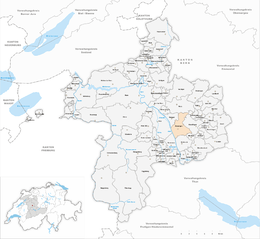Münsingen
| Münsingen | ||
|---|---|---|

Münsingen Castle
|
||
|
||
| Coordinates: 46°52′N 7°34′E / 46.867°N 7.567°ECoordinates: 46°52′N 7°34′E / 46.867°N 7.567°E | ||
| Country | Switzerland | |
| Canton | Bern | |
| District | Bern-Mittelland | |
| Government | ||
| • Executive |
Gemeinderat with 7 members |
|
| • Mayor | Gemeindepräsident | |
| • Parliament |
Gemeindeparlament with 30 members |
|
| Area | ||
| • Total | 15.75 km2 (6.08 sq mi) | |
| Elevation | 541 m (1,775 ft) | |
| Population (Dec 2015) | ||
| • Total | 12,199 | |
| • Density | 770/km2 (2,000/sq mi) | |
| Postal code | 3110 | |
| SFOS number | 0616 | |
| Surrounded by | Belp, Gerzensee, Konolfingen, Rubigen, Tägertschi, Trimstein, Wichtrach | |
| Twin towns | Münsingen (Germany), Humpolec (Czech Republic) | |
| Website |
www SFSO statistics |
|
Münsingen is a municipality in the Bern-Mittelland administrative district in the canton of Bern in Switzerland. On 1 January 2013 the former municipality of Trimstein merged into Münsingen, and on 1 January 2017 the former municipality of Tägertschi also merged.
The village lies on the River Aare between the cities of Bern and Thun.
Münsingen developed from a Celtic village first settled in around 400 BC. The origin of the name is unclear, though attributed to the Alamanni. During the early and middle La Tene era the residents of the village built about 220 tombs along the Aare river. Some of the men were buried with their weapons and the women and children were buried with jewelry. A total of 1,200 items were discovered from the village. The rich collection of artifacts and the clear stratigraphic layers at Münsingen have helped archeologists to develop a model for dating isolated graves from Germany to Romania to Italy. The relatively small number of individuals combined with the rich grave goods indicate that the settlement at Münsingen was home to Celtic nobility. Two of the graves contain skulls that show evidence of trepanation or holes bored into the skull.
During the Roman era there was a country estate or very small settlement near where the village church stands today. Scattered fragments of a wall and a bath house have been discovered. The bath house floor was decorated with mosaics depicting fishes and the god Oceanus. The bath house is probably from the 2nd century AD.
...
Wikipedia



